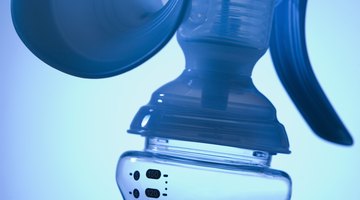If I Pump & Blood Gets in the Bottle Is It Still OK to Give the Baby?
It can be frightening to notice blood in pumped breast milk, particularly if you're not sure what caused the bleeding. Breast-feeding mothers should note that their babies already drink many of their bodily fluids, including small quantities of blood cells, according to Lise Eliot in her book, "What's Going On In there?" Consequently, in most cases, it's safe to give breast milk to your baby, even if there's blood in it.
Common Bleeding Causes
A number of minor illnesses can cause bloody breast milk. Mastitis, an infection that commonly afflicts breast-feeding women, can cause:
- small quantities of blood
- puss to seep from the nipples
- according to pediatrician William Sears in his book
- "The Portable Pediatrician." Similarly, dry and cracked nipples may bleed directly into a breast pump
in some cases, the pump itself might cause bleeding by exerting too much force on sensitive and irritated nipples.
Breast Milk Safety

Nipple Compression During Breastfeeding
Learn More
La Leche League's "The Womanly Art of Breastfeeding" concurs that breast milk with blood in it usually is safe. There are some exceptions to this rule, however. Women with HIV/AIDS should not give their babies breast milk containing blood. If you recently have suffered from a systemic infection such as sepsis, hepatitis or other serious illness, consult your doctor before feeding your baby. Eliot explains that, in most cases, even mothers with infections can breast-feed, but some infections can be passed to the baby.
Storing Bloody Milk
La Leche League explains that the most common concern associated with blood in breast milk has nothing to do with safety. Babies might reject breast milk containing significant amounts of blood because of the strong iron taste. The taste tends to get stronger when milk is refrigerated or stored for several hours. To prevent your baby from rejecting the milk, feed her right away if possible.
Preventing Bleeding

Milk Blisters When Not Breastfeeding
Learn More
If you are unsure why your nipples are bleeding or don't know how blood got into your breast milk, seek medical care. Mastitis and similar infections almost always require antibiotics. Without proper treatment, the milk ducts may temporarily close, rendering breast-feeding impossible, according to Sears. Apply lanolin to your nipples to ease cracking and dryness. A poor latch and improper positioning also can cause bloody and painful nipples, so consider asking a lactation consultant for help.
Related Articles
- The Portable Pediatrician; William Sears, M.D. et al.
- What's Going On In There?; Lise Eliot
- The Womanly Art of Breastfeeding; La Leche League International











